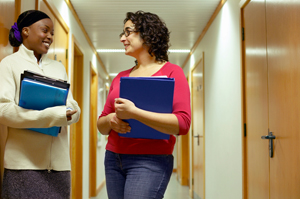 Math is often perceived as a challenging subject to teach and to learn. This line of thinking often stems from early learning experiences that relied on traditional teaching models. Today, more teachers are embracing non–content area books to help students understand and apply abstract mathematical concepts.
Math is often perceived as a challenging subject to teach and to learn. This line of thinking often stems from early learning experiences that relied on traditional teaching models. Today, more teachers are embracing non–content area books to help students understand and apply abstract mathematical concepts.
Our experiences with integrating reading and math have convinced us that if we teach math skills and concepts using popular children’s books, we can effectively engage and teach even the most reluctant learners.
In some important ways, learning to read and learning math are different. However, conceptualizing mathematical thinking using age-appropriate, quality children’s literature allows for productive experiences that enhance students’ mastery of the subject.
Working together, we developed guidelines for selecting books, concluding that the books must allow us to
- Connect to our students’ background knowledge
- Bridge abstract knowledge to concrete knowledge
- Apply new knowledge to real-world situations
With these guidelines in mind, we then generated a list of timeless classics. Two main selections and activities proved especially effective.
Amazing Grace. Mary Hoffman. Caroline Binch. 1991. Dial. Make spiders and have students number the legs on the spiders. Allow children to count (by twos) the legs on the spider. Push the math concepts of the book forward by providing coins from the U.S. and Trinidad so that students can compare the coins and use them to purchase the spiders made in class.
All by Myself. Mercer Mayer. 2001. Random House. Using ordinal numbers, recount the sequence of events in the book. Have children use teddy bear cookies as counters to vote on the kind of juice they want to have with their cookies for snack. To reinforce the book’s main idea, make a graph illustrating the number of students who have little sisters, little brothers, or neither.
The activities above can be used with a variety of books and adapted for use with children from pre-K through second grade. If early childhood educators use books that are carefully selected and pre-examined for their value in teaching mathematical concepts and skills, the children will be motivated to engage productively in learning. They will ask more questions, make more requests, and become involved in useful learning experiences, just as mouse did when he was given a cookie.
 Delilah Davis is an assistant professor in reading and early childhood at Texas Southern University. She serves as the director of Field Experience and Clinical Practice.
Delilah Davis is an assistant professor in reading and early childhood at Texas Southern University. She serves as the director of Field Experience and Clinical Practice.
 Ingrid Haynes is an associate professor in reading and middle grades at Texas Southern University. She serves as the department chair for Curriculum and Instruction.
Ingrid Haynes is an associate professor in reading and middle grades at Texas Southern University. She serves as the department chair for Curriculum and Instruction.
Delilah Davis and Ingrid Haynes, along with Summer Pannell and Reginald Todd, will present a session titled “Literacy Strategies for Improving Mathematics; Developing Autonomous, Self-Directed Learners” at the ILA 2017 Conference & Exhibits, held in Orlando, FL, July 15–17.